
C7
.pdf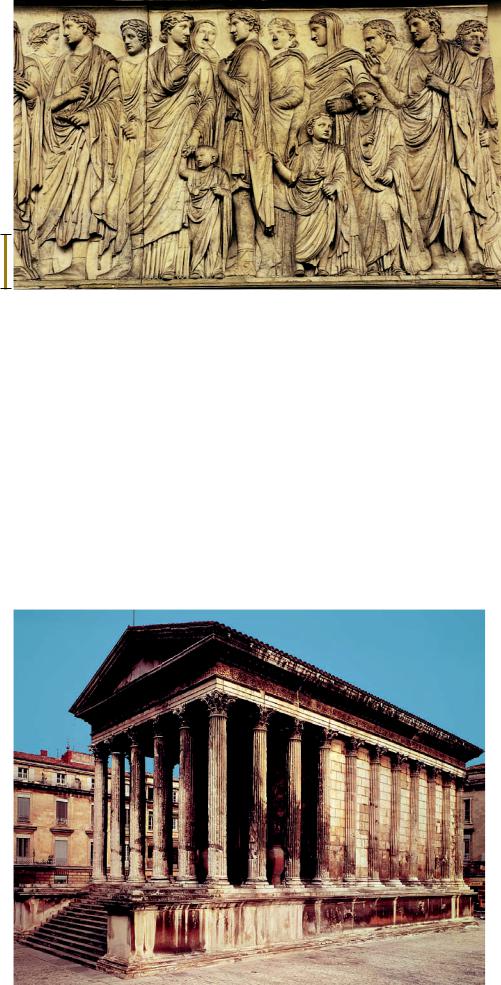
1 ft.
portrayed are children, who restlessly tug on their elders’ garments and talk to one another when they should be quiet on a solemn occa- sion—in short, children who act like children and not like miniature adults, as they frequently do in the history of art. Their presence lends a great deal of charm to the procession, but that is not why children were included on the Ara Pacis when they had never before appeared on any Greek or Roman state monument. Augustus was concerned about a decline in the birthrate among the Roman nobility, and he enacted a series of laws designed to promote marriage, marital fi- delity, and raising children. The portrayal of men with their families on the Altar of Peace served as a moral exemplar. Once again, the emperor used art to further his political and social agendas.
FORUM OF AUGUSTUS Augustus’s most ambitious project in the capital was the construction of a new forum (FIG. 7-2, no. 10) next to Julius Caesar’s forum (FIG. 7-2, no. 9), which Augustus completed. Both forums featured white marble from Carrara (ancient
7-31 Procession of the imperial family, detail of the south frieze of the Ara Pacis Augustae, Rome, Italy, 13–9 BCE. Marble, 5 3 high.
Although inspired by the Panathenaic procession frieze (FIG. 5-50) of the Parthenon, the Ara Pacis friezes depict recognizable individuals, including children. Augustus promoted marriage and childbearing.
Luna). Prior to the opening of these quarries in the second half of the first century BCE, marble had to be imported at great cost from abroad, and the Romans used it sparingly. The ready availability of Italian marble under Augustus made possible the
emperor’s famous boast that he found Rome a city of brick and transformed it into a city of marble.
The extensive use of Carrara marble for public monuments (including the Ara Pacis) must be seen as part of Augustus’s larger program to make his city the equal of Periclean Athens. In fact, the Forum of Augustus incorporated several explicit references to Classical Athens and to the Acropolis in particular, most notably copies of the caryatids (FIG. 5-54) of the Erechtheion in the upper story of the porticos. The forum also evoked Roman history. The porticos contained dozens of portrait statues, including images of all the major figures of the Julian family going back to Aeneas. Augustus’s forum became a kind of public atrium filled with imagines. His family history thus became part of the Roman state’s official history.
NÎMES The Forum of Augustus is in ruins today, but many scholars believe some workers on that project also erected the socalled Maison Carrée (Square House; FIG. 7-32) at Nîmes (ancient
7-32 Maison Carrée, Nîmes, France, ca. 1–10 CE.
This exceptionally well preserved Corinthian pseudoperipteral temple in France, modeled on the Temple of Mars Ultor in Rome, exemplifies the conservative Neo-Classical Augustan architectural style.
Early Empire |
177 |
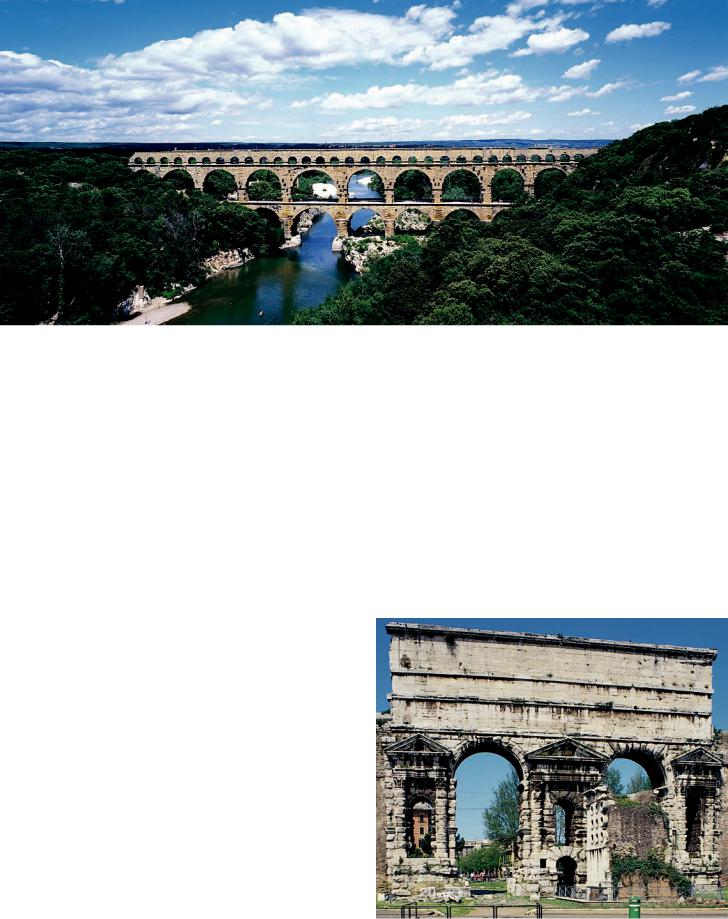
7-33 Pont-du-Gard, Nîmes, France, ca. 16 BCE.
Roman engineers constructed roads and bridges throughout the empire. This aqueduct bridge brought water from a distant mountain spring to Nîmes—about 100 gallons a day for each inhabitant.
Nemausus) in southern France (ancient Gaul). This exceptionally well preserved Corinthian pseudoperipteral temple, which dates to the opening years of the first century CE, is the best surviving example of the Augustan Neo-Classical architectural style.
An earlier Augustan project at Nîmes was the construction of the great aqueduct-bridge known today as the Pont-du-Gard (FIG. 7-33). Beginning in the fourth century BCE, the Romans built aqueducts to carry water from mountain sources to their city on the Tiber River. As Rome’s power spread through the Mediterranean world, its architects constructed aqueducts, roads, and bridges to serve colonies throughout the far-flung empire. The Pont-du-Gard demonstrates the skill of Rome’s engineers. The aqueduct provided about 100 gallons of water a day for each inhabitant of Nîmes from a source some 30 miles away. The water was carried over the considerable distance by gravity alone, which required channels built with a continuous gradual decline over the entire route from source to city. The three-story bridge at Nîmes maintained the height of the water channel where the water crossed the Gard River. Each large arch spans some 82 feet and is constructed of blocks weighing up to two tons each. The bridge’s uppermost level consists of a row of smaller arches, three above each of the large openings below. They carry the water channel itself. Their quickened rhythm and the harmonious proportional relationship between the larger and smaller arches reveal that the Roman engineer had a keen aesthetic as well as practical sense.
PORTA MAGGIORE Many aqueducts were required to meet the demand for water in the capital. Under the emperor Claudius (r. 41–54 CE), a grandiose gate, the Porta Maggiore (FIG. 7-34), was constructed at the point where two of Rome’s water lines (and two intercity trunk roads) converged. Its huge attic (uppermost story) bears a wordy dedicatory inscription that conceals the conduits of both aqueducts, one above the other. The gate is the outstanding example of the Roman rusticated (rough) masonry style. Instead of using the precisely shaped blocks Greek and Augustan architects preferred, the designer of the Porta Maggiore combined smooth and rusticated surfaces. These created an exciting, if eccentric, facade
with crisply carved pediments resting on engaged columns composed of rusticated drums.
NERO’S GOLDEN HOUSE In 64 CE, when Nero (r. 54–68 CE), stepson and successor of Claudius, was emperor, a great fire destroyed large sections of Rome. Architects carried out the rebuilding in accordance with a new code that required greater fireproofing, resulting in the widespread use of concrete, which was both cheap and fire resistant. Increased use of concrete gave Roman builders the opportunity to explore the possibilities opened up by the still relatively new material.
7-34 Porta Maggiore, Rome, Italy, ca. 50 CE.
This double gateway, which supports the water channels of two important aqueducts, is the outstanding example of Roman rusticated (rough) masonry, which was especially popular under Claudius.
178 Chapter 7 T H E RO M A N E M P I R E
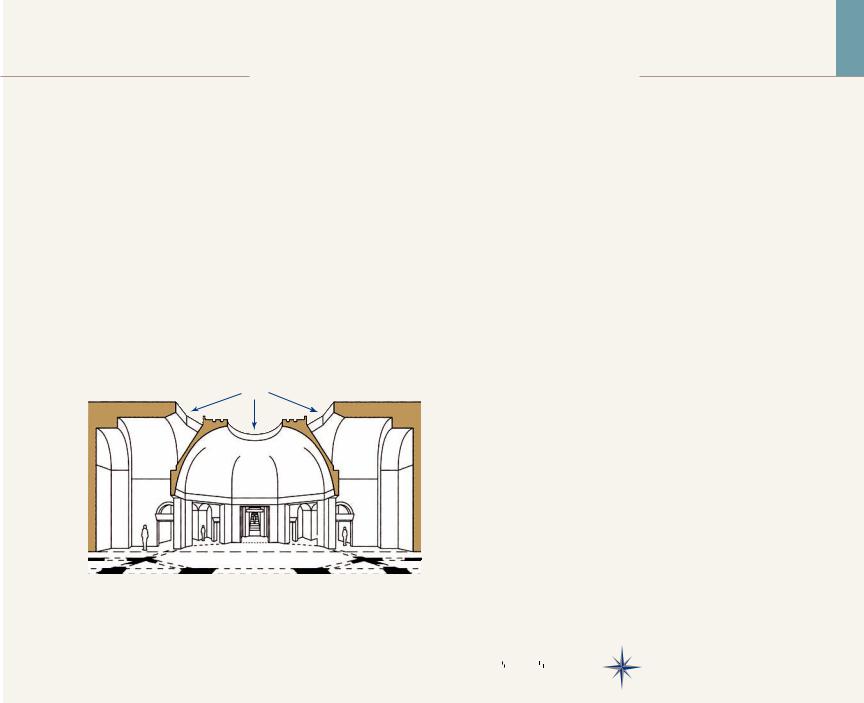
W R I T T E N S O U R C E S
The Golden House of Nero
Nero’s Domus Aurea (FIG. 7-35), or Golden House, was a vast and notoriously extravagant country villa in the heart of Rome. The second-century CE Roman biographer Suetonius de-
scribed it vividly:
The entrance-hall was large enough to contain a huge statue [of Nero in the guise of Sol, the sun god, by Zenodorus; FIG. 7-2,
no. 16], 120 feet high; and the pillared arcade ran for a whole mile. An enormous pool, like a sea, was surrounded by buildings made to resemble cities, and by a landscape garden consisting of ploughed fields, vineyards, pastures, and woodlands—where every variety of domestic and wild animal roamed about. Parts of the house were
overlaid with gold and studded with precious stones and mother-of- pearl. All the dining-rooms had ceilings of fretted ivory, the panels of which could slide back and let a rain of flowers, or of perfume from hidden sprinklers, shower upon [Nero’s] guests. The main
Light
7-35 SEVERUS and CELER, section (left) and plan (right) of the octagonal hall of the Domus Aurea (Golden House) of Nero, Rome, Italy, 64–68 CE.
Nero’s architects illuminated this octagonal room by placing an oculus in its concrete dome, and ingeniously lit the rooms around it by leaving spaces between their vaults and the dome’s exterior.
dining-room was circular, and its roof revolved, day and night, in time with the sky. Sea water, or sulphur water, was always on tap in the baths. When the palace had been decorated throughout in this lavish style, Nero dedicated it, and condescended to remark: “Good, now I can at last begin to live like a human being!”*
Suetonius’s description is a welcome reminder that the Roman ruins tourists flock to see are but a dim reflection of the magnificence of the original structures. Only in rare instances, such as the Pantheon, with its marble-faced walls and floors (FIG. 7-51), can visitors experience anything approaching the architects’ intended effects. Even there, much of the marble paneling is of later date, and the gilding is missing from the dome.
*Suetonius, Nero, 31. Translated by Robert Graves, Suetonius: The Twelve Caesars (New York: Penguin, 1957; illustrated edition, 1980), 197–198.
Oculus
N
0 |
15 |
30 feet |
|||
|
|
|
|
|
|
0 |
5 |
|
10 meters |
||
After the great fire, Nero asked SEVERUS and CELER, two brilliant architect-engineers, to construct a grand new palace for him on a huge confiscated plot of fire-ravaged land near the Forum Romanum (see “The Golden House of Nero,” above). Nero’s Domus Aurea had scores of rooms, many adorned with frescoes (FIG. 7-22) in the Fourth Style, others with marble paneling or painted and gilded stucco reliefs. Structurally, most of these rooms, although built of concrete, are unremarkable. One octagonal hall (FIG. 7-35), however, stands apart from the rest and testifies to Severus and Celer’s entirely new approach to architectural design.
The ceiling of the octagonal room is a dome that modulates from an eight-sided to a hemispherical form as it rises toward the oculus—the circular opening that admitted light to the room. Radiating outward from the five inner sides (the other three, directly or indirectly, face the outside) are smaller, rectangular rooms, three covered by barrel vaults, two others (marked by a broken-line X on the plan; FIG. 7-35, right) by the earliest known concrete groin vaults.
Severus and Celer ingeniously lit these satellite rooms by leaving spaces between their vaulted ceilings and the central dome’s exterior. But the most significant aspect of the design is that here, for the first time, the architects appear to have thought of the walls and vaults not as limiting space but as shaping it.
Today, the octagonal hall no longer has its stucco decoration and marble incrustation (veneer). The concrete shell stands bare, but this serves to focus the visitor’s attention on the design’s spatial complexity. Anyone walking through the rooms sees that the central domed octagon is defined not by walls but by eight angled piers. The wide square openings between the piers are so large that the rooms beyond look like extensions of the central hall. The grouping of spatial units of different sizes and proportions under a variety of vaults creates a dynamic three-dimensional composition that is both complex and unified. Nero’s architects were not only inventive but also progressive in their recognition of the malleable nature of concrete, a material not limited to the rectilinear forms of traditional architecture.
Early Empire |
179 |
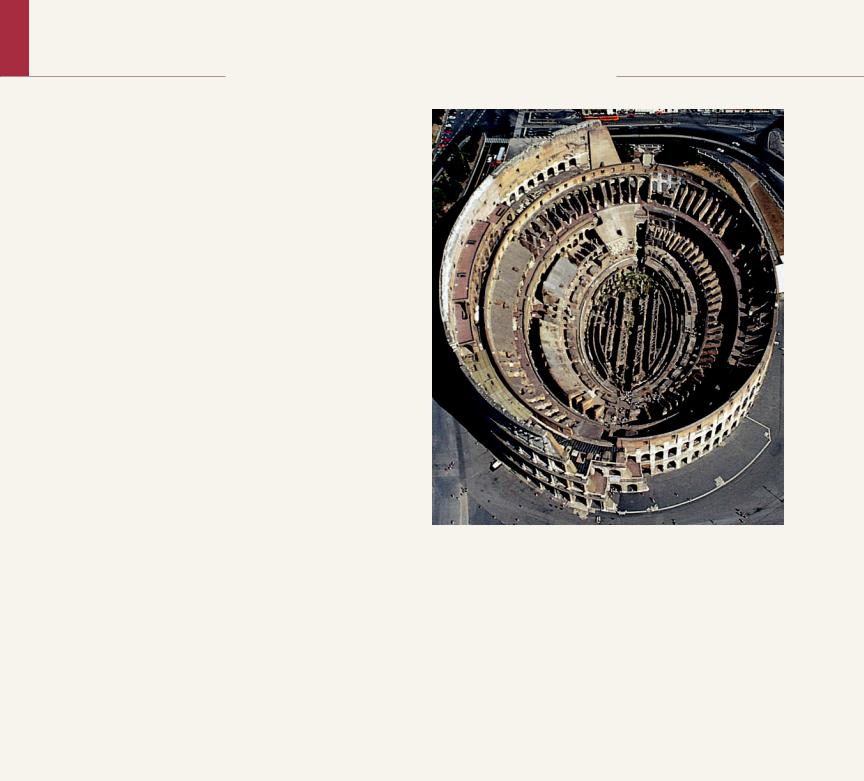
A R T A N D S O C I E T Y
Spectacles in the Colosseum
Romans flocked to amphitheaters all over the Empire to see two main kinds of spectacles: gladiatorial combats and animal hunts.
Gladiators were professional fighters, usually slaves who had been purchased to train as hand-to-hand combatants in gladiatorial schools. Their owners, seeking to turn a profit, rented them out for performances. Beginning with Domitian, however, all gladiators who competed in Rome were state-owned to ensure that they could not be used as a private army to overthrow the government. Although every gladiator faced death every time he entered the arena, some had long careers and achieved considerable fame. Others, for example, criminals or captured enemies, were sent into the amphitheater without any training and without any defensive weapons. Those “gladiatorial games” were a form of capital punishment coupled with entertainment for the masses.
Wild animal hunts (venationes) were also immensely popular. Many of the hunters were also professionals, but often the hunts, like the gladiatorial games, were executions in thin disguise involving helpless prisoners who were easy prey for the animals. Sometimes no one would enter the arena with the animals. Instead, skilled archers shot the beasts with arrows from positions in the stands. Other times animals would be pitted against other animals—bears versus bulls, lions versus elephants, and such—to the delight of the crowds.
The Colosseum (FIG. 7-36) was the largest and most important amphitheater in the world, and the kinds of spectacles staged there were costlier and more impressive than those held anywhere else. There are even accounts of the Colosseum being flooded so that naval battles could be staged before an audience of tens of thousands, although some scholars have doubted that the arena could be made watertight or that ships could maneuver in the space available.
In the early third century, the historian Dio Cassius described the ceremonies Titus sponsored at the inauguration of the Colosseum in 80.
There was a battle between cranes and also between four elephants; animals both tame and wild were slain to the number of nine thousand; and women . . . took part in despatching them. As for the men, several fought in single combat and several groups contended together both in infantry and naval battles. For Titus suddenly filled [the arena] with water and brought in horses and bulls and some other domesticated animals that had been taught to behave in the liquid element just as on land. He also brought in people on ships, who engaged in a sea-
7-36 Aerial view of the Colosseum (Flavian Amphitheater), Rome, Italy, ca. 70–80 CE.
A complex system of concrete barrel vaults once held up the seats in the world’s largest amphitheater, where 50,000 spectators could watch gladiatorial combats and wild animal hunts.
fight there. . . . On the first day there was a gladiatorial exhibition and wild-beast hunt. . . . On the second day there was a horse-race, and on the third day a naval battle between three thousand men, followed by an infantry battle. . . . These were the spectacles that were offered, and they continued for a hundred days.*
*Dio Cassius, Roman History, 66.25. Translated by Earnest Cary, Dio’s Roman History, vol. 8 (Cambridge, Mass.: Harvard University Press, 1925), 311, 313.
The Flavians
Because of his outrageous behavior, Nero was forced to commit suicide in 68 CE, bringing the Julio-Claudian dynasty to an end. A year of renewed civil strife followed. The man who emerged triumphant in this brief but bloody conflict was Vespasian (r. 69–79 CE), a general who had served under Claudius and Nero. Vespasian, whose family name was Flavius, had two sons, Titus (r. 79–81 CE) and Domitian (r. 81–96 CE). The Flavian dynasty ruled Rome for more than a quarter century.
COLOSSEUM The Flavians left their mark on the capital in many ways, not the least being the construction of the Colosseum (FIGS. 7-2, no. 17, and 7-36), the monument that, for most people, still represents Rome more than any other building. In the past it
was identified so closely with Rome and its empire that in the early Middle Ages there was a saying, “While stands the Colosseum, Rome shall stand; when falls the Colosseum, Rome shall fall; and when Rome falls—the World.”2 The Flavian Amphitheater, as it was known in its day, was one of Vespasian’s first undertakings after becoming emperor. The decision to build the Colosseum was very shrewd politically. The site chosen was the artificial lake on the grounds of Nero’s Domus Aurea, which engineers drained for the purpose. By building the new amphitheater there, Vespasian reclaimed for the public the land Nero had confiscated for his private pleasure and provided Romans with the largest arena for gladiatorial combats and other lavish spectacles that had ever been constructed. The Colosseum takes its name, however, not from its size—it could
180 Chapter 7 T H E RO M A N E M P I R E
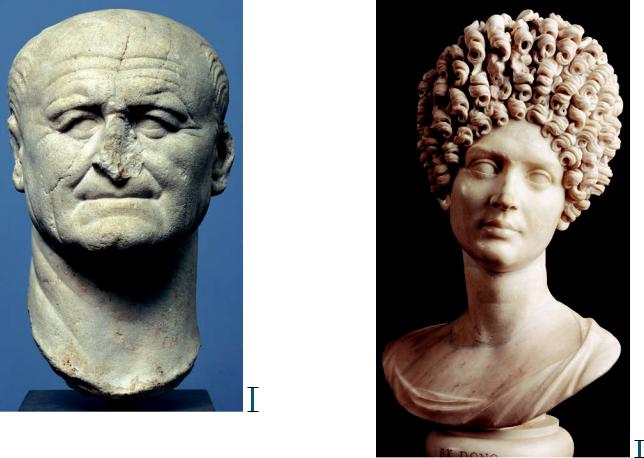
7-37 Portrait |
7-38 Portrait |
|
of Vespasian, |
bust of a Flavian |
|
ca. 75–79 CE. |
woman, from |
|
Marble, 1 4 high. |
Rome, Italy, |
|
Ny Carlsberg |
ca. 90 CE. |
|
Glyptotek, |
Marble, 2 1 |
|
Copenhagen. |
high. Musei |
|
Vespasian’s sculp- |
Capitolini, |
|
Rome. |
||
tors revived the |
||
|
||
veristic tradition |
The Flavian |
|
of the Republic to |
sculptor repro- |
|
underscore the |
duced the |
|
elderly new em- |
elaborate |
|
peror’s Republican |
coiffure of this |
|
values in contrast |
elegant woman |
|
to Nero’s self- |
by drilling deep |
|
indulgence and |
holes for the |
|
extravagance. |
corkscrew curls |
|
|
and carved the |
|
|
rest of the hair |
|
|
and the face |
|
|
with hammer |
|
|
and chisel. |
1 in.
hold more than 50,000 spectators—but from its location beside the Colossus of Nero (FIG. 7-2, no. 16), the huge statue at the entrance to his urban villa. Vespasian did not live to see the Colosseum in use. Titus completed and formally dedicated the amphitheater in 80 CE with great fanfare (see “Spectacles in the Colosseum,” page 180).
The Colosseum, like the much earlier amphitheater at Pompeii (FIG. 7-13), could not have been built without concrete. A complex system of barrel-vaulted corridors holds up the enormous oval seating area. This concrete “skeleton” is apparent today to anyone who enters the amphitheater (FIG. 7-36). In the centuries following the fall of Rome, the Colosseum served as a convenient quarry for ready-made building materials. Almost all its marble seats were hauled away, exposing the network of vaults below. Hidden in antiquity but visible today are the arena substructures, which in their present form date to the third century. They housed waiting rooms for the gladiators, animal cages, and machinery for raising and lowering stage sets as well as animals and humans. Cleverly designed lifting devices brought beasts from their dark dens into the arena’s bright light. Above the seats a great velarium, as at Pompeii (FIG. 7-14), once shielded the spectators. Poles affixed to the Colosseum’s facade held up the giant awning.
The exterior travertine shell (FIG. 7-1) is approximately 160 feet high, the height of a modern 16-story building. Numbered entrances led to the cavea, where the spectators sat according to their place in the social hierarchy. The relationship of the 76 gateways to the tiers of seats within was carefully thought out and resembles the systems seen in modern sports stadiums. The decor of the exterior, however, had nothing to do with function. The facade is divided into four bands, with large arched openings piercing the lower three. Ornamental Greek orders frame the arches in the standard Roman sequence for multistoried buildings: from the ground up, Tuscan, Ionic, and then Corinthian. This sequence is based on the proportions of the orders, with the Tuscan viewed as capable of supporting the heaviest load. Corinthian pilasters (and between them the brackets for the wooden poles that held up the velarium) circle the uppermost story.
1 in.
The use of engaged columns and a lintel to frame the openings in the Colosseum’s facade is a variation of the scheme seen on the Etruscan Porta Marzia (FIG. 6-14) at Perugia. The Romans commonly used this scheme from Late Republican times on. Like the pseudoperipteral temple, which is an eclectic mix of Greek orders and Etruscan plan, this manner of decorating a building’s facade combined Greek orders with an architectural form foreign to Greek post-and-lintel architecture, namely the arch. The Roman practice of framing an arch with an applied Greek order had no structural purpose, but it added variety to the surface. It also unified a multistoried facade by casting a net of verticals and horizontals over it.
FLAVIAN PORTRAITURE Vespasian was an unpretentious career army officer who desired to distance himself from Nero’s extravagant misrule. His portraits (FIG. 7-37) reflect his much simpler tastes. They also made an important political statement. Breaking with the tradition Augustus established of depicting the Roman emperor as an eternally youthful god on earth, Vespasian’s sculptors resuscitated the veristic tradition of the Republic, possibly at his specific direction. Although not as brutally descriptive as many Republican likenesses, Vespasian’s portraits frankly recorded his receding hairline and aging, leathery skin—proclaiming his traditional Republican values in contrast to Nero’s.
Portraits of people of all ages survive from the Flavian period, in contrast to the Republic, when only elders were deemed worthy of depiction. A portrait bust (FIG. 7-38) of a young woman is a case in point. Its purpose was to project not Republican virtues but rather idealized beauty—through contemporary fashion rather than by reference to images of Greek goddesses. The portrait is notable for its elegance and delicacy and for the virtuoso way the sculptor rendered the differing textures of hair and flesh. The elaborate Flavian coiffure,
Early Empire |
181 |
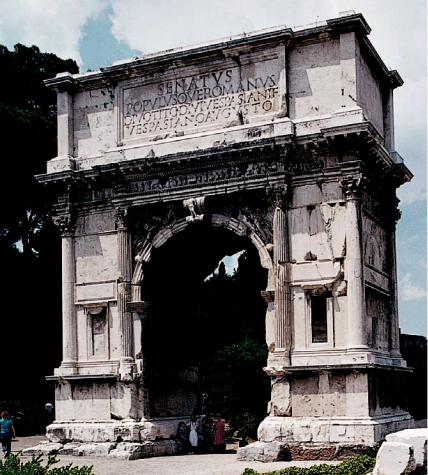
7-39 Arch of Titus, Rome, Italy, after 81 CE.
Domitian erected this arch on the road leading into the Roman Forum to honor his brother, the emperor Titus, who became a god after his death. Victories fill the spandrels of the arcuated passageway.
with its corkscrew curls punched out using a drill instead of a chisel, creates a dense mass of light and shadow set off boldly from the softly modeled and highly polished skin of the face and swanlike neck. The drill played an increasing role in Roman sculpture in succeeding periods and in time was used even for portraits of men, when much longer hair and full beards became fashionable.
ARCH OF TITUS When Titus died in 81 CE, only two years after becoming emperor, his younger brother, Domitian, succeeded him. Domitian erected an arch (FIGS. 7-2, no. 13, and 7-39) in Titus’s honor on the Sacred Way leading into the Republican Forum Romanum (FIG. 7-2, no. 11). This type of arch, the so-called triumphal arch, has a long history in Roman art and architecture, beginning in the second century BCE. The term is something of a misnomer, however, because Roman arches celebrated more than just military victories. Freestanding arches, usually crowned by gilded-bronze statues, commemorated a wide variety of events, ranging from victories abroad to the building of roads and bridges at home.
The Arch of Titus is typical of the early triumphal arch and consists of one passageway only. As on the Colosseum, engaged columns frame the arcuated opening, but their capitals are the Composite type, an ornate combination of Ionic volutes and Corinthian acanthus leaves that became popular at about the same time as the Fourth Style in Roman painting. Reliefs depicting personified Victories (winged women, as in Greek art) fill the spandrels (the area between the arch’s curve and the framing columns and entablature). A dedicatory inscription stating that the arch was erected to honor the god Titus, son of the god Vespasian, dominates the attic. Roman
emperors normally were proclaimed gods after they died, unless they ran afoul of the Senate and were damned. The statues of those who suffered damnatio memoriae were torn down, and their names were erased from public inscriptions. This was Nero’s fate.
Inside the passageway of the Arch of Titus are two great relief panels. They represent the triumphal parade of Titus down the Sacred Way after his return from the conquest of Judaea at the end of the Jewish Wars in 70 CE. One of the reliefs (FIG. 7-40) depicts Roman soldiers carrying the spoils—including the sacred sevenbranched candelabrum, the menorah—from the Temple in Jerusalem. Despite considerable damage to the relief, the illusion of movement is convincing. The parade moves forward from the left background into the center foreground and disappears through the obliquely placed arch in the right background. The energy and swing of the column of soldiers suggest a rapid march. The sculptor rejected the Classical low-relief style of the Ara Pacis (FIG. 7-31) in favor of extremely deep carving, which produces strong shadows. The heads of the forward figures have broken off because they stood free from the block. Their high relief emphasized their different placement in space compared with the heads in low relief, which are intact. The play of light and shadow across the protruding foreground and receding background figures enhances the sense of movement.
The panel (FIG. 7-41) on the other side of the passageway shows Titus in his triumphal chariot. The seeming historical accuracy of the spoils panel—it closely corresponds to the Jewish historian Josephus’s contemporaneous description of Titus’s triumph— gave way in this panel to allegory. Victory rides with Titus in the four-horse chariot and places a wreath on his head. Below her is a
182 Chapter 7 T H E RO M A N E M P I R E
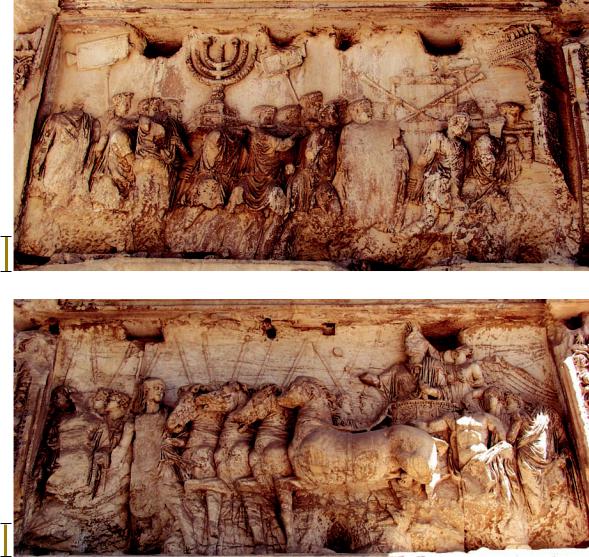
7-40 Spoils of Jerusalem, relief panel from the Arch of Titus, Rome, Italy, after 81 CE. Marble, 7 10 high.
The reliefs inside the bay of the Arch of Titus commemorate the emperor’s greatest achievement—the conquest of Judaea. Here, Roman soldiers carry the spoils from the Jewish temple in Jerusalem.
1 ft.
7-41 Triumph of Titus, relief panel from the Arch of Titus, Rome, Italy, after 81 CE. Marble, 7 10 high.
Victory crowns Titus in his triumphal chariot. Also present are personifications of Honor and Valor in this first known instance of the intermingling of human and divine figures in a Roman historical relief.
1 ft.
bare-chested youth who is probably a personification of Honor (Honos). A female personification of Valor (Virtus) leads the horses. These allegorical figures transform the relief from a record of Titus’s battlefield success into a celebration of imperial virtues. Such an intermingling of divine and human figures occurs on the Republican Villa of the Mysteries frieze (FIG. 7-18) at Pompeii, but the Arch of Titus panel is the first known instance of divine beings interacting with humans on an official Roman historical relief. (On the Ara Pacis, FIG. 7-29, Aeneas and “Tellus” appear in separate framed panels, carefully segregated from the procession of living Romans.) The Arch of Titus was erected after the emperor’s death, and its reliefs were carved when Titus was already a god. Soon afterward, however, this kind of interaction between mortals and immortals became a staple of Roman narrative relief sculpture, even on monuments honoring a living emperor.
HIGH EMPIRE
In the second century CE, under Trajan, Hadrian, and the Antonines, the Roman Empire reached its greatest geographic extent (MAP 7-1) and the height of its power. Rome’s might was unchallenged in the Mediterranean world, although the Germanic peoples in Europe, the Berbers in Africa, and the Parthians and Persians in the Near East
constantly applied pressure. Within the empire’s secure boundaries, the Pax Romana meant unprecedented prosperity for all who came under Roman rule.
Trajan
Domitian’s extravagant lifestyle and ego resembled Nero’s. He demanded to be addressed as dominus et deus (lord and god) and so angered the senators that he was assassinated in 96 CE. The Senate chose the elderly Nerva, one of its own, as emperor. Nerva ruled for only 16 months, but before he died he established a pattern of succession by adoption that lasted for almost a century. Nerva picked Trajan, a capable and popular general born in Italica (Spain), as the next emperor. Trajan was the first non-Italian to rule Rome. Under Trajan, imperial armies brought Roman rule to ever more distant areas (MAP 7-1), and the imperial government took on ever greater responsibility for its people’s welfare by instituting a number of farsighted social programs. Trajan was so popular that the Senate granted him the title Optimus (the Best), an epithet he shared with Jupiter (who was said to have instructed Nerva to choose Trajan as his successor). In Late Antiquity, Augustus, the founder of the Roman Empire, and Trajan became the yardsticks for success. The goal of new emperors was to be felicior Augusto, melior Traiano (luckier than Augustus, better than Trajan).
High Empire |
183 |

7-42 Aerial view of Timgad (Thamugadi), Algeria, founded 100 CE.
Timgad, like other new Roman colonies, was planned with great precision. Its strict grid scheme features two main thoroughfares, the cardo and the decumanus, with the forum at their intersection.
TIMGAD In 100 CE, Trajan founded a new colony for army veterans at Timgad, ancient Thamugadi (FIG. 7-42), in what is today Algeria. Like other colonies, Timgad became the physical embodiment of Roman authority and civilization for the local population and served as a key to the Romanization of the provinces. The town
was planned with great precision, its design resembling that of a Roman military encampment or castrum. (Scholars still debate which came first. The castrum may have been based on the layout of Roman colonies.) Unlike the sprawling unplanned cities of Rome and Pompeii, Timgad is a square divided into equal quarters by its two main streets, the cardo and the decumanus. They cross at right angles and are bordered by colonnades. Monumental gates once marked the ends of the two avenues. The forum is located at the point where the streets intersect. The quarters are subdivided into square blocks, and the forum and public buildings, such as the theater and baths, occupy areas sized as multiples of these blocks. The Roman plan is a modification of the Hippodamian plan of Greek cities (FIG. 5-76), though more rigidly ordered.
The fact that most of these colonial settlements were laid out in the same manner, regardless of whether they were in North Africa, Mesopotamia, or England, expresses concretely the unity and centralized power of the Roman Empire at its height. But even the Romans could not regulate human behavior completely. As the aerial view reveals, when the population of Timgad grew sevenfold and burst through the Trajanic colony’s walls, rational planning was ignored, and the city and its streets branched out haphazardly.
FORUM OF TRAJAN Trajan completed several major building projects in Rome, including the remodeling of the Circus Maximus (FIG. 7-2, no. 2), Rome’s giant chariot-racing stadium, and the construction of a vast new bathing complex near the Colosseum constructed on top of Nero’s Golden House. His most important undertaking, however, was a huge new forum (FIGS. 7-2, no. 7, and 7-43), roughly twice the size of the century-old Forum of Augustus (FIG. 7-2, no. 10)—even excluding the enormous market complex next to the forum. The new forum glorified Trajan’s victories in his two wars against the Dacians (who lived in what is now Romania) and was paid for with the spoils of those campaigns. The architect
3
2
4
3
5
6
7-43 APOLLODORUS OF DAMASCUS,
Forum of Trajan, Rome, Italy, dedicated 112 CE (James E. Packer and John Burge).
(1) Temple of Trajan, (2) Column of Trajan,
(3) libraries, (4) Basilica Ulpia, (5) forum,
(6) equestrian statue of Trajan.
With the spoils from two Dacian wars, Trajan built
Rome’s largest forum. It featured an equestrian statue of the emperor,
statues of Dacian captives, two libraries, and a basilica with clerestory lighting.
184 Chapter 7 T H E RO M A N E M P I R E
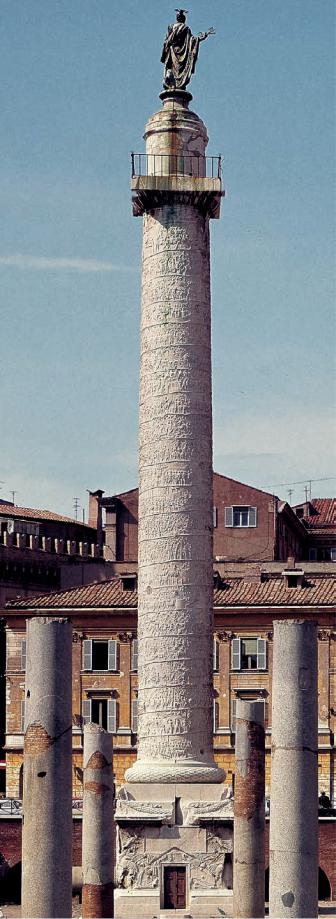
was APOLLODORUS OF DAMASCUS, Trajan’s chief military engineer during the Dacian Wars. Apollodorus’s plan incorporated the main features of most early forums (FIG. 7-12), except that a huge basilica, not a temple, dominated the colonnaded open square. The temple (completed after the emperor’s death and dedicated to the newest god in the Roman pantheon, Trajan himself) was set instead behind the basilica. It stood at the rear end of the forum in its own courtyard, with two libraries and a giant commemorative column, the Column of Trajan (FIGS. 7-43, no. 2, and 7-44).
Entry to Trajan’s forum was through an impressive gateway resembling a triumphal arch. Inside the forum were other reminders of Trajan’s military prowess. A larger-than-life-size gilded-bronze equestrian statue of the emperor stood at the center of the great court in front of the basilica. Statues of captive Dacians stood above the columns of the forum porticos.
The Basilica Ulpia (Trajan’s family name was Ulpius) was a much larger and far more ornate version of the basilica in the forum of Pompeii (FIG. 7-12, no. 3). As shown in FIG. 7-43, no. 4, it had apses, or semicircular recesses, on each short end. Two aisles flanked the nave on each side. In contrast to the Pompeian basilica, the entrances were on the long side facing the forum. The building was vast: about 400 feet long (without the apses) and 200 feet wide. Light entered through clerestory windows, made possible by elevating the timber-roofed nave above the colonnaded aisles. In the Republican basilica at Pompeii, light reached the nave only indirectly through aisle windows. The clerestory (used millennia before at Karnak in Egypt, FIG. 3-26) provided much better illumination.
COLUMN OF TRAJAN The Column of Trajan (FIG. 7-44) was probably also the brainchild of Apollodorus of Damascus. The idea of covering the shaft of a colossal freestanding column with a continuous spiral narrative frieze seems to have been invented for this monument, but it was often copied in antiquity, the Middle Ages (FIG. 11-25), and as late as the 19th century. Trajan’s column is 128 feet high. It once featured a heroically nude statue of the emperor at the top. (The present statue of Saint Peter dates to the 16th century.) The tall pedestal, decorated with captured Dacian arms and armor, served as Trajan’s tomb.
Scholars have likened the 625-foot band that winds around the column to an illustrated scroll of the type housed in the neighboring libraries (and that Lars Pulena holds on his sarcophagus, FIG. 6-15). The reliefs depict Trajan’s two successful campaigns against the Dacians. The story unfolds in more than 150 episodes in which some 2,500 figures appear. The band increases in width as it winds to the top of the column, so that it is easier to see the upper portions. Throughout, the relief is very low so as not to distort the contours of the shaft. Paint enhanced the legibility of the figures, but a viewer still would have had difficulty following the narrative from beginning to end.
Much of the spiral frieze is given over to easily recognizable compositions such as those found on coin reverses and on historical relief panels: Trajan addressing his troops, sacrificing to the gods, and so on. The narrative is not a reliable chronological account of the Dacian Wars, as was once thought. The sculptors nonetheless accurately recorded the general character of the campaigns. Notably, battle scenes take up only about a quarter of the frieze. As is true of modern military operations, the Romans spent more time constructing forts, transporting men and equipment, and preparing for battle than fighting. The focus is always on the emperor, who appears throughout the frieze, but the enemy is not belittled. The Romans won because of their superior organization and more powerful army, not because they were inherently superior beings.
7-44 Column of Trajan, Forum of Trajan, Rome, Italy, dedicated 112 CE.
The spiral frieze of Trajan’s column tells the story of the Dacian Wars in 150 episodes. All aspects of the campaigns were represented, from battles to sacrifices to road and fort construction.
High Empire |
185 |
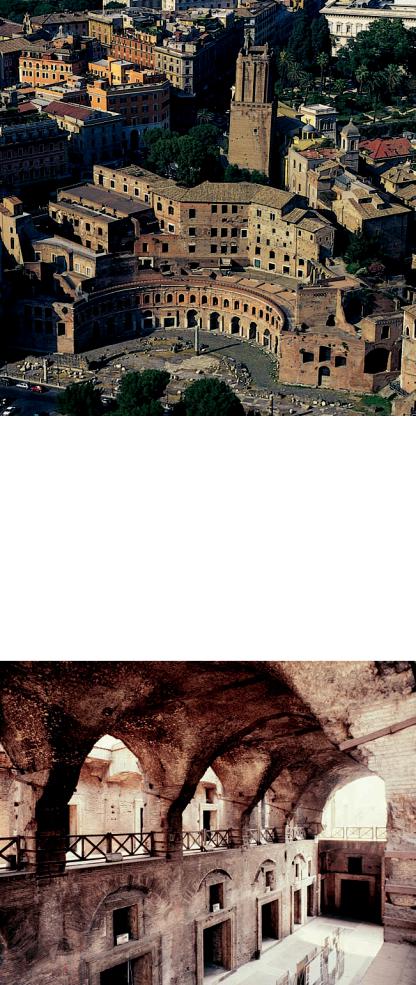
7-45 APOLLODORUS OF DAMASCUS, aerial view of the
Markets of Trajan, Rome, Italy, ca. 100–112 CE.
Apollodorus of Damascus used brick-faced concrete to transform the Quirinal Hill overlooking Trajan’s forum in Rome into a vast multilevel complex of barrel-vaulted shops and administrative offices.
MARKETS OF TRAJAN On the Quirinal Hill overlooking the forum, Apollodorus built the Markets of Trajan (FIGS. 7-2, no. 8, and 7-45) to house both shops and administrative offices. As earlier at Palestrina (FIG. 7-5), concrete made possible the transformation of a natural slope into a multilevel complex. Trajan’s architect was a master of this modern medium as well as of the traditional stone-and-timber post-and-lintel architecture of the forum below. The basic unit was the taberna, a single-room shop covered by a barrel vault. Each taberna had a wide doorway, usually with a window above it that allowed light to enter a wooden inner attic used for storage. The shops were on several levels. They opened either onto a hemispherical facade winding around one of the great exedras of Trajan’s forum, onto a paved street farther up the hill, or onto a great in-
door market hall (FIG. 7-46) resembling a modern shopping mall. The hall housed two floors of shops, with the upper shops set back on each side and lit by skylights. Light from the same sources reached the ground-floor shops through arches beneath the great umbrella-like groin vaults (FIG. 7-6c) covering the hall.
ARCH OF TRAJAN, BENEVENTO In 109 CE, Trajan opened a new road, the Via Traiana, in southern Italy. Several years later the Senate erected a great arch (FIG. 7-47) honoring Trajan at the point where the road entered Benevento (ancient Beneventum). Architecturally, the Arch of Trajan at Benevento is almost identical
7-46 APOLLODORUS OF DAMASCUS, interior of the great
hall, Markets of Trajan, Rome, Italy, ca. 100–112 CE.
The great hall of Trajan’s markets resembles a modern shopping mall. It housed two floors of shops, with the upper ones set back and lit by skylights. Concrete groin vaults cover the central space.
to Titus’s arch (FIG. 7-39) in Rome, but relief panels cover both facades of the Trajanic arch, giving it a billboardlike function. Every inch of the surface heralded the emperor’s achievements. In one panel, he enters Rome after a successful military campaign. In another, he distributes largesse to needy children. In still others, he is portrayed as the founder of colonies for army veterans and as the builder of a new port at Ostia, Rome’s harbor at the mouth of the Tiber. The reliefs present Trajan as the guarantor of peace and security in the empire, the benefactor of the poor, and the patron of soldiers and merchants alike. In short, the emperor is all things to all people. In several of the panels, Trajan freely intermingles with
186 Chapter 7 T H E RO M A N E M P I R E
